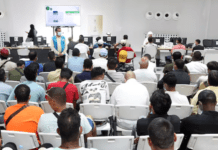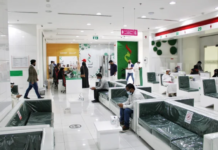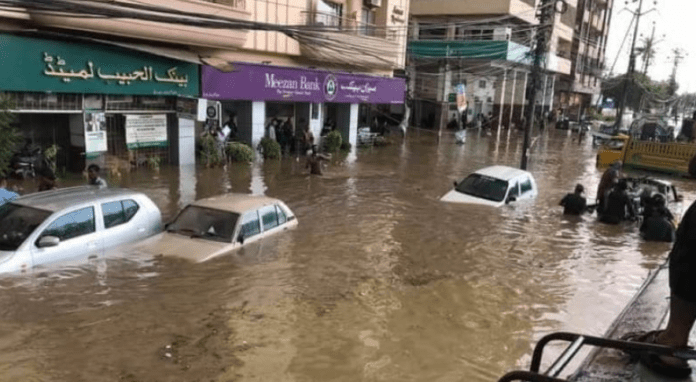The UAE News Report: Karachi, the ‘City of Light’ and ATM of the Government of Pakistan, again becomes Venice after a few hours of heavy downpours. Several areas of the city including major arteries are still clogged as rainwater has not been drained from there yet.
Pakistan Peoples Party enjoyed 15 years of government in Sindh but Karachi was not on the party’s agenda for any kind of development. Now Bhutto’s party claims that they will pay special attention to Karachi after winning the Election 2024 but Karachiites are not fools. Pakistan Peoples Party’s Karachi Mayor Murtaza Wahab did nothing to deal with rainwater in Karachi before and now and asking Karachiites to stay home.
Cloudy weather throughout the day
The Met Office has predicted intermittent rain and cloudy weather throughout the day in Karachi today, a day after a heavy downpour caused urban flooding in several parts of the port city.
The Met Office said nimbus clouds persisted in central and northern areas of the city, which received intermitted rains. “The series of rains may continue intermittently till evening,” the meteorological department said adding that it was after 40 years that the city was witnessing such rainfall in February.
The current temperature in the metropolis is 19.9 C, whereas winds are blowing at the speed of 8km an hour from northeast, the PMD said. It said the winds are expected to blow at the speed of 20-25 km an hour during the day.
The humidity was recorded at 92% in the metropolis, the Met Office said.
Several areas of the city including major arteries are still clogged as rainwater has not been drained from there yet. This includes Qayyumabad Chowrangi, I.I. Chundrigar Road, Burns Road, Arts Council, Korangi Industrial Area Road from Godown Chowrangi to Chamra Chowrangi, Shah Faisal Colony area near Shama Centre. Because of this, people have to take long routes to reach their destinations.
Water could not be cleared from the premises of public hospitals and the roads leading to them, including the Jinnah Postgraduate Medical Centre and National Institute of Cardiovascular Diseases.
Whereas, rainwater has been drained from Safoora Chowrangi, Gurumandir, Hassan Square and Essa Nagri.
Several areas experienced hours-long power outages due to heavy rainfall. Electricity supply to Gulistan-e-Johar Block 8 and Jamshed Road has been suspended since Saturday night. The road near Gulistan-e-Johar underpass has collapsed creating hurdle in traffic flow.
Heavy rain coupled with thunder and lightning Saturday night wreaked havoc in parts of Karachi as rainwater mixed with sewage overflowing from choked lines entered houses and hospitals in the port city.
Areas that received downpours included Baldi Town, Orangi Town, North Karachi, Surjani Town, Gulshan-e-Meymar, Korangi, Landhi, DHA, Shah Faisal Colony, Malir, Orangi Town, Bahria Town, Saddar, North Nazimabad, Tower, Liaquatabad and Nazimabad.
Following the rain, major arteries in the mega city were submerged with rainwater and commuters were stuck in their vehicles as the city administration had not taken any measures to cope with the rain, despite the PMD’s forecast for heavy rain a day earlier.
Parts of the city’s main artery Sharea Faisal were completely submerged with water and scores of cars broke down that further disrupted the traffic movement on Saturday night.
As the rainwater entered the Drigh Road underpass and could not be drained for a long period, chaos ensued on Sharea Faisal.
No emergency response by the city administration showed as if the rain had taken them by surprise and they had no preparations.
The Gizri underpass was also flooded with rainwater and was closed for the traffic movement.
District Central’s Nagan Chowrangi, Five Star Chowrangi, Disco Mor and Surjani Town were also completely flooded with rainwater.
In a few areas, rainwater also entered houses. In District East, the under-construction University Road was completely flooded with rainwater bringing traffic to a standstill for hours.
Many people returning from offices were stuck on roads for hours before they could reach homes.
A statement issued by the officer of Karachi Mayor Murtaza Wahab said drainage work was commenced in areas after rainfall had subsided there.
The mayor directed the relevant municipal officials to ensure that rainwater was not accumulated in any area.
Commuters faced troubles due to accumulated water mixed with sewage overflowing from choked lines on most of the roads, including MA Jinnah Road and II Chundrigar Road.
With the first drop of rainfall, different parts of the port city, including North Nazimabad, North Karachi, Korangi, Gulistan-e-Johar and its suburban areas, plunged into darkness because of an electricity supply failure.
Shara-e-Faisal sees highest rainfall
According to statistics issued by the PMD, the highest rainfall was recorded at 75 millimeters on Shara-e-Faisal in the last 24 hours followed by Malir and Surjani Town at 64 and 63.8 millimeters respectively.
Keamari received 55 millimeters of rainfall, Quaidabad 52, Airport area 51, Gulshan-e-Hadeed 50, Masroor Base 47.2, Jinnah Terminal 42 and Saad Town 37.6 millimeters.
Whereas, rainfall in North Karachi was recorded 33.6 millimeters, 30 millimeters on the University Road, 23.8 in Gulshan-e-Meymar, 23.5 in Nazimabad and 15 in Korangi.
Parts of Karachi without electricity after heavy rain
Heavy rain coupled with thunder and lightning Saturday night wreaked havoc in parts of Karachi. Following the rain, major arteries in the PORT city were submerged with rainwater and commuters were stuck in their vehicles as the city administration had not taken any measure to cope with the rain, despite the Pakistan Meteorological Department (PMD) had forecast heavy rain a day earlier.
With the first drop of rainfall, different parts of the port city, including North Nazimabad, Sir Syed Town, Adam Town, UP Morr, New Karachi, Yousaf Goth, Gulshan-e-Iqbal, Rashid Minhas Road, Liaquatabad, DHA, Gharibabad, Gulshan-e-Maymar, Ahsan Abad, Korangi, Landhi, Garden, Sher Shah, Baldia and other areas, plunged into darkness due to an electricity supply failure.
As per the data from the Pakistan Meteorological Department (PMD), PAF Faisal Base received the highest amount of rainfall recorded at 75 millimetres, followed by Malir (64mm), Surjani Town (63.8mm), Keamari (55mm), Quaidabad (52mm), old airport area (51mm), Gulshan-i-Hadeed (50mm), PAF Masroor Base (47.2mm), Jinnah Terminal (42mm), Saadi Town (37.6mm), North Karachi (33.6mm), University Road (30mm), Gulshan-i-Maymar (23.8mm), Nazimabad (23.5mm), Korangi (15mm) with trace rainfall in Orangi Town and DHA.
700 power feeders trip in Karachi
Intense rain results in flooding on various roads, causing motorcycles and cars to come to a standstill. Heavy rains on Saturday wreaked havoc in various areas of Karachi, leaving roads submerged and more than 700 electricity feeders tripped, plunging several neighbourhoods into darkness, Express News reported.
The rain started after sunset, just as the Pakistan Meteorological Department (PMD) had predicted, and rapidly intensified across almost all areas of the city.
Areas including Landhi, Korangi, DHA, Clifton, II Chundrigar Road, Tower, Keamari, Bolton Market, Saddar, Gulistan-e-Jauhar, Gulshan-e-Iqbal, Nipa, Liaquatabad, North Nazimabad, North Karachi and Surjani experienced heavy rainfall for over 20 minutes, accompanied by strong gusts of wind.
The intense rain resulted in flooding on various city roads, causing motorcycles and cars to come to a standstill.
According to PMD, 75mm of rainfall was recorded at PAF Base Faisal (Shahrae Faisal), 64mm in Malir Halt, 63.8mm in Surjani, 55mm in Keamari, 52mm in Quaidabad and 51mm in the Old Airport area.
Moreover, Gulshan-e-Hadeed experienced 50mm of rainfall, 47.2 at PAF Base Masroor, 42mm at Jinnah Terminal, 37.6mm in Saadi Town, 33.6mm in North Karachi, 23.8mm in Gulshan-e-Maymar, 23.5mm in Nazimabad, and 15mm in Korangi.
In addition to the flooded roads, more than 700 electricity feeders tripped in different areas of the city after the rain, leading to power outages in Liaquatabad, Gulshan-e-Iqbal, Nazimabad, PIB, Maymar, Landhi and other areas.
Furthermore, due to poor drainage, urban flooding occurred in several areas of Karachi, causing inconvenience to residents.
KWSB CEO Engineer Syed Salahuddin Ahmed has imposed emergency measures in the city following the rain, directing the technical staff to remain vigilant and active at all times.
Earlier, PMD had predicted heavy rainfall in Karachi on February 3 and 4.







































